- Lots & Transactions
- Inventory Manager
- Transactions
- Manage Germplasm Inventory Functions
- Manage Studies Inventory Functions
Lots & Transactions
Inventory reservations, withdrawals, and deposits are recorded as transactions within a lot. Each lot is associated with a Lot UID suitable for barcoding. The Inventory Manager allows for the creation of lots independently of studies and permits a single germplasm ID (GID) to be associated with numerous lots to support the following types of inventory activities:
- Deposit and withdraw inventory for germplasm created by crossing and advancement within BMS studies.
- Deposit and withdraw inventory for germplasm created outside of the BMS (no associated BMS study).
- Split the inventory of a single lot between physical locations. For example, create multiple lots of a single GID to distribute between regional programs.
- Merge mulitple lots.
Inventory Manager
The inventory manager allows you to browse, view, filter and manage lots and transactions.

This Maize program includes 4415 lots with available inventory.
Lot Filters
From View Lots you have the ability to filter lots by any detail or combination of details.
- Filter lots by any detail or combination of details. Select the detail from the "Search by" drop down and add to filter by selecting the + button.

Filter Example: Germplasm List
- Select Germplasm List to reveal the filter options. Select the list(s) of interest and Ok.

The two list selected represent 120 germplasm entries.
 The two germplasm lists, consisting of 120 germplasm entries, are represented by 125 lots, because some of the germplasm entries contain mulitple lots.
The two germplasm lists, consisting of 120 germplasm entries, are represented by 125 lots, because some of the germplasm entries contain mulitple lots.Filter Example: Available
- Select Available to reveal options for filtering available inventory. Enter the min/max of interest and Apply. Entering min value alone will reveal all lots with a equal to or greater than available amount.
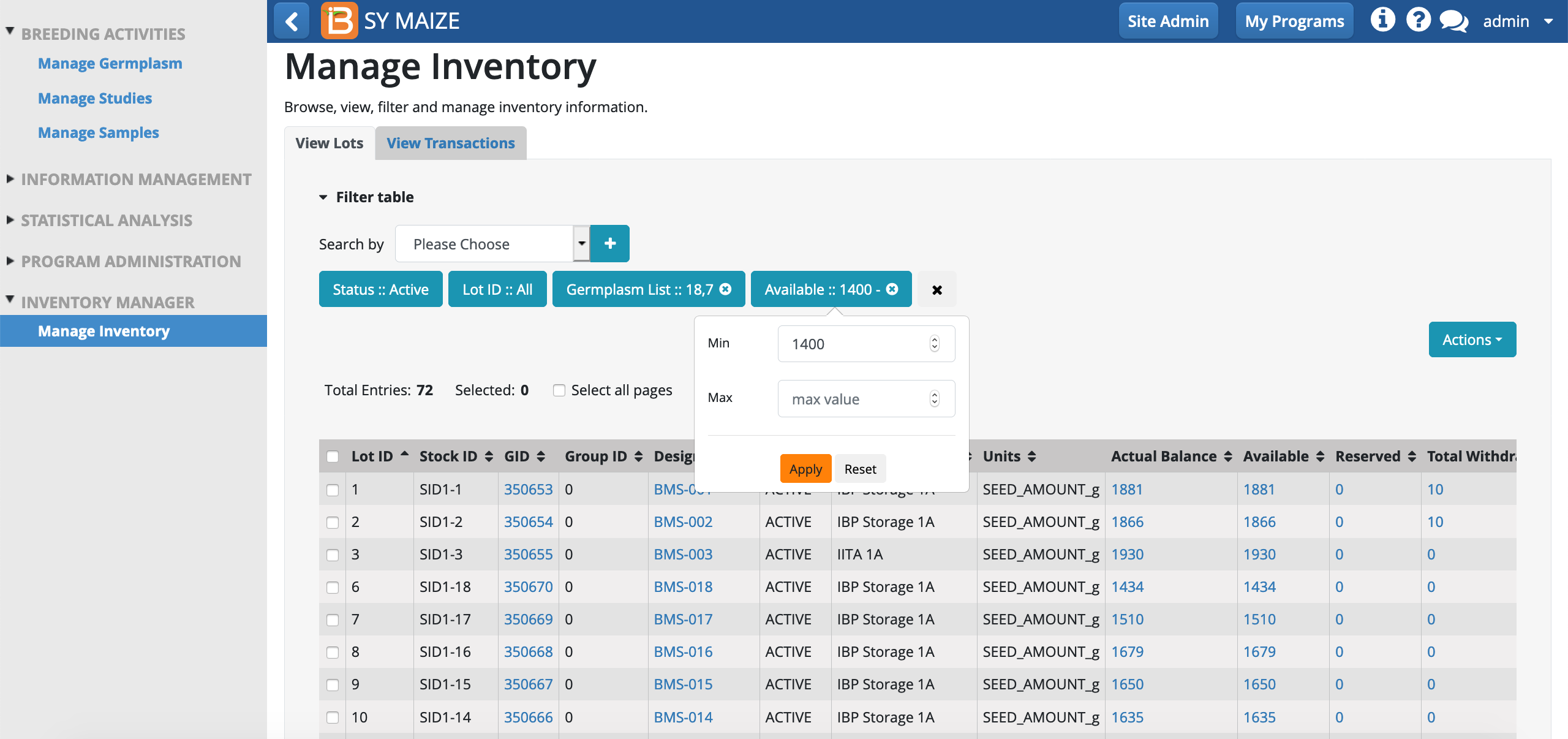
This search reveals that 72 lots contain greater than 1400g of seed.
Filter Example: Designation
- Select Designation to search germplasm designations containing matching text.
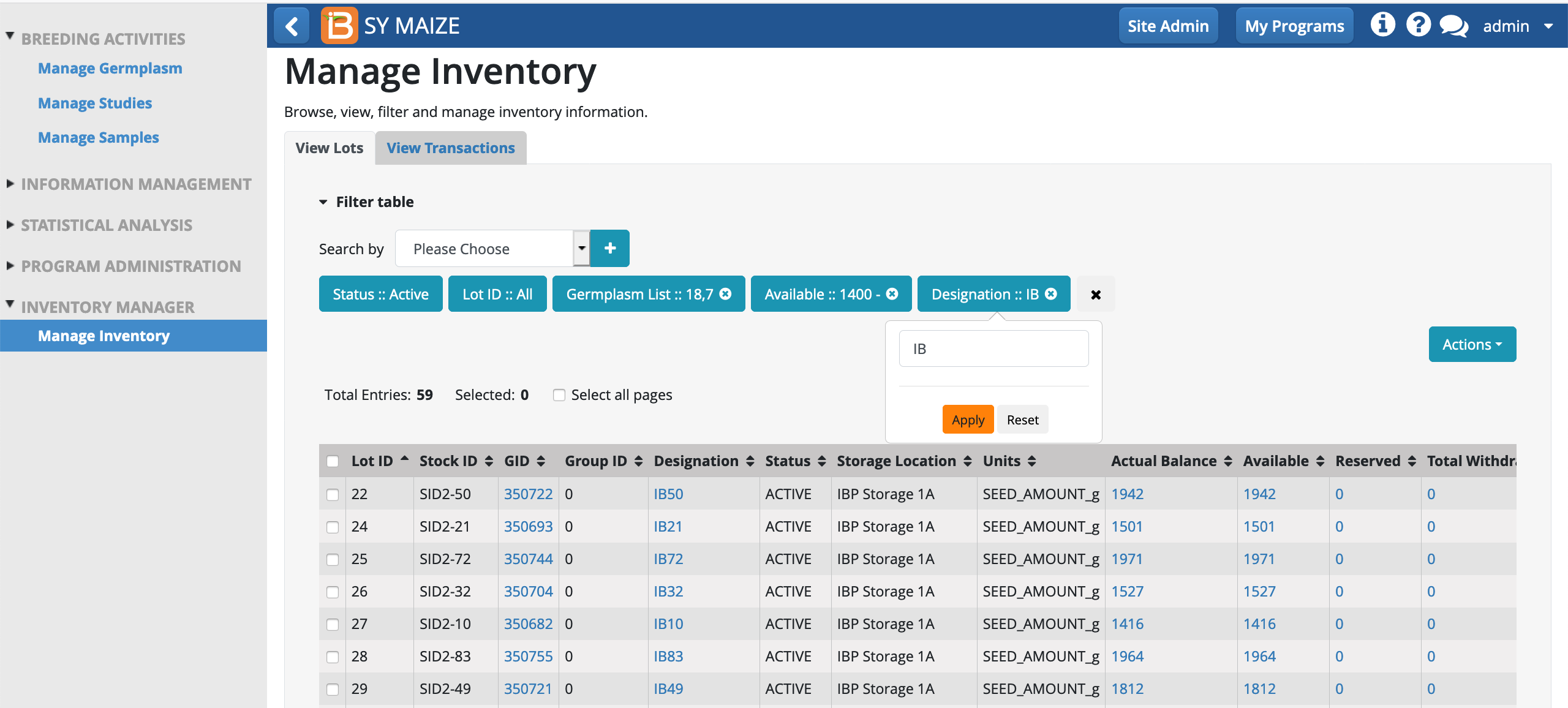
This search reveals 59 lots with designations containing the text, "IB".
Lot Actions

Import lots
Import lots allows you to batch create lots with the option to include an initial deposit transaction using an .xls file. This action requires that germplasm already exist in the system with GIDs. (See related topics: Import Germplasm, Crossing, Selections )
- Select Import lots from Action menu. Download the template (.xls)

The following columns of data are mandatory for import of lots: GID, STORAGE LOCATION ABBR, UNITS, AMOUNT.
 The Codes page of the .xls file provides guidance on how to format STORAGE LOCATION ABBR and UNITS. These options are customizable via Manage Ontology
The Codes page of the .xls file provides guidance on how to format STORAGE LOCATION ABBR and UNITS. These options are customizable via Manage Ontology
-
Edit the import lots template. Obtain the GIDs by exporting from the Germplasm Manager. Save file.

Notice that GID 395616 has two lots specified. The lots are recorded in different units and stored in different locations.
- Browse to saved file (.xls) and import.

- If you did not specify a Stock ID in the template file, you will be asked to customize a prefix. Stock ID prefix cannot end in a number. Confirm.

If the import is successful, you will receive a confirmation message and the list of germplasm is now updated with active lots lots and an initial lot transaction.
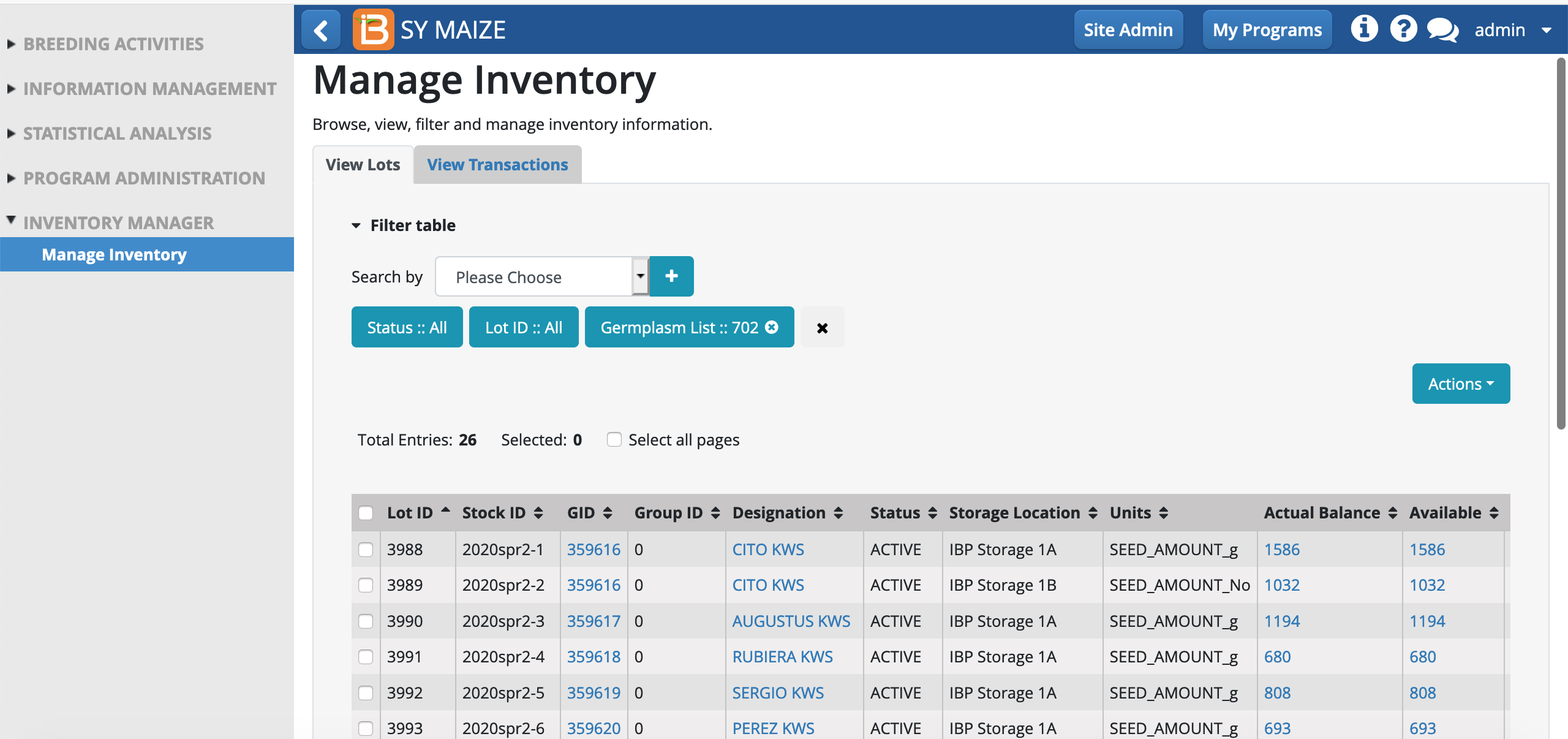
Create lots
Create lots allows you to create lot one at a time through the user interface (see Import Lots above for batch functionality). This function also provides the option to specify an initial deposit amount. This action requires that germplasm already exist in the system with GIDs. (See related topics: Import Germplasm, Crossing, Selections )
- Select Create lots from Action menu. Fill the details. Stock ID prefix cannot end in a number. Save.
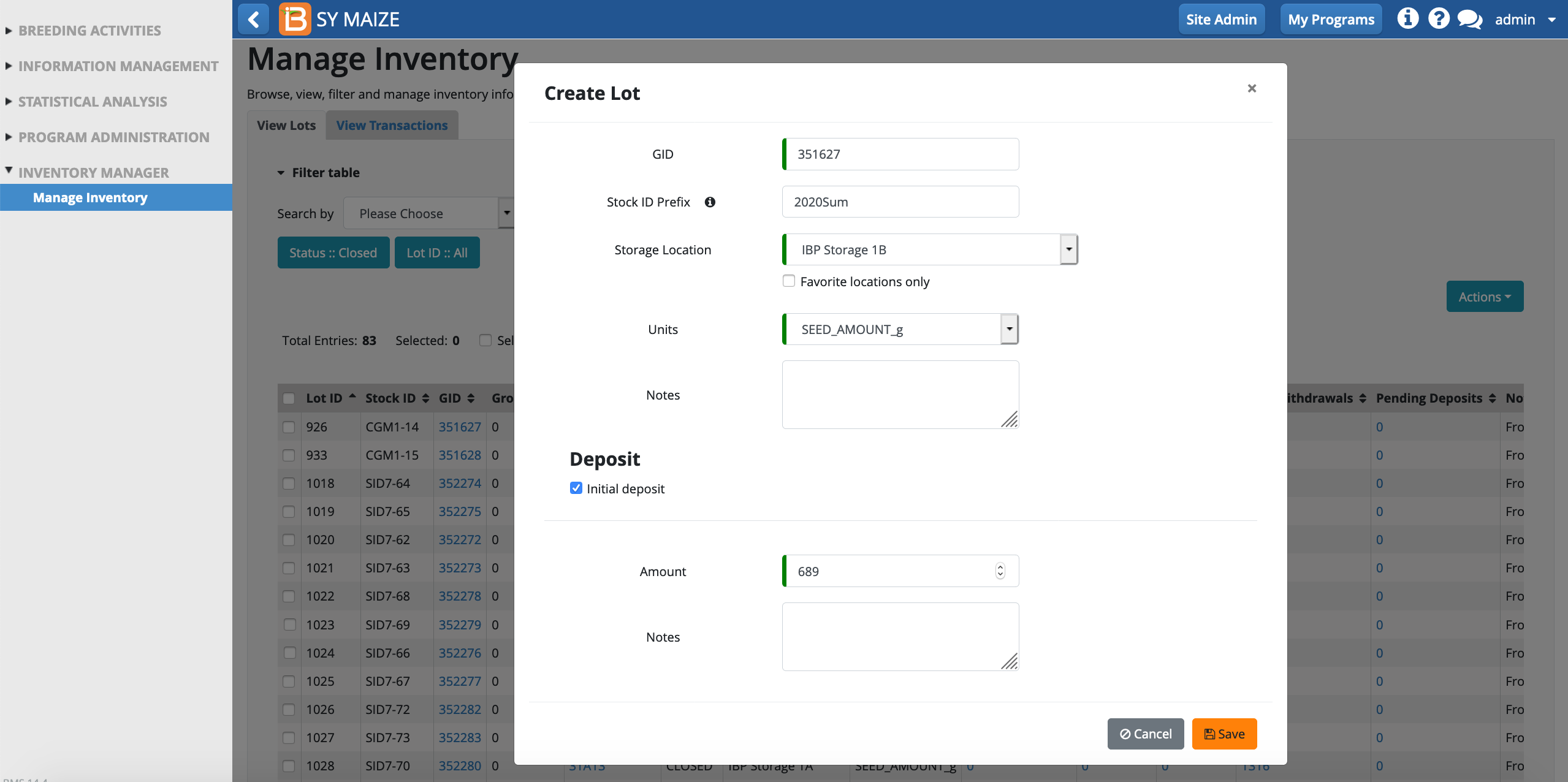
If the import is successful, you will receive a confirmation message and the germplasm is now updated with a lot.

Import Lot Updates
Edit .xls filebased on Lot UID (See below for more information, Export data and lables)
- Change storage location
- Units
- Notes

- Save .xls import file. Select Import Lot Updates from Actions menu and specify the file. Map the headers and import.
Merge Lots
When there is reason to belive the lot are genetically equivalent, inventory from multiple lots can be merged into a single lot.
- Select the lots to merge.

- Choose a single lot to receive all of the inventory.

- Confirm the closure of the other lots.
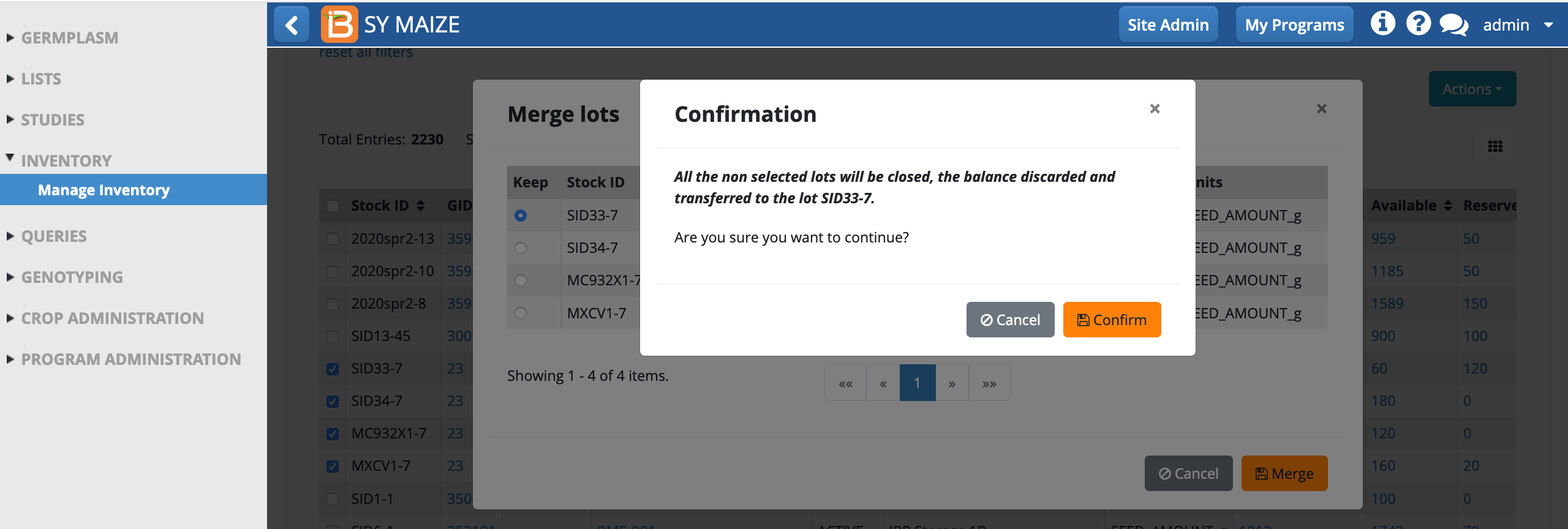
The selected lot now contains all the inventory of the lots selected for merger.

Split Lot
- Split a single selected lot into two lots by choosing Split lot from the Actions menu.

- Specify new lot details. Save.
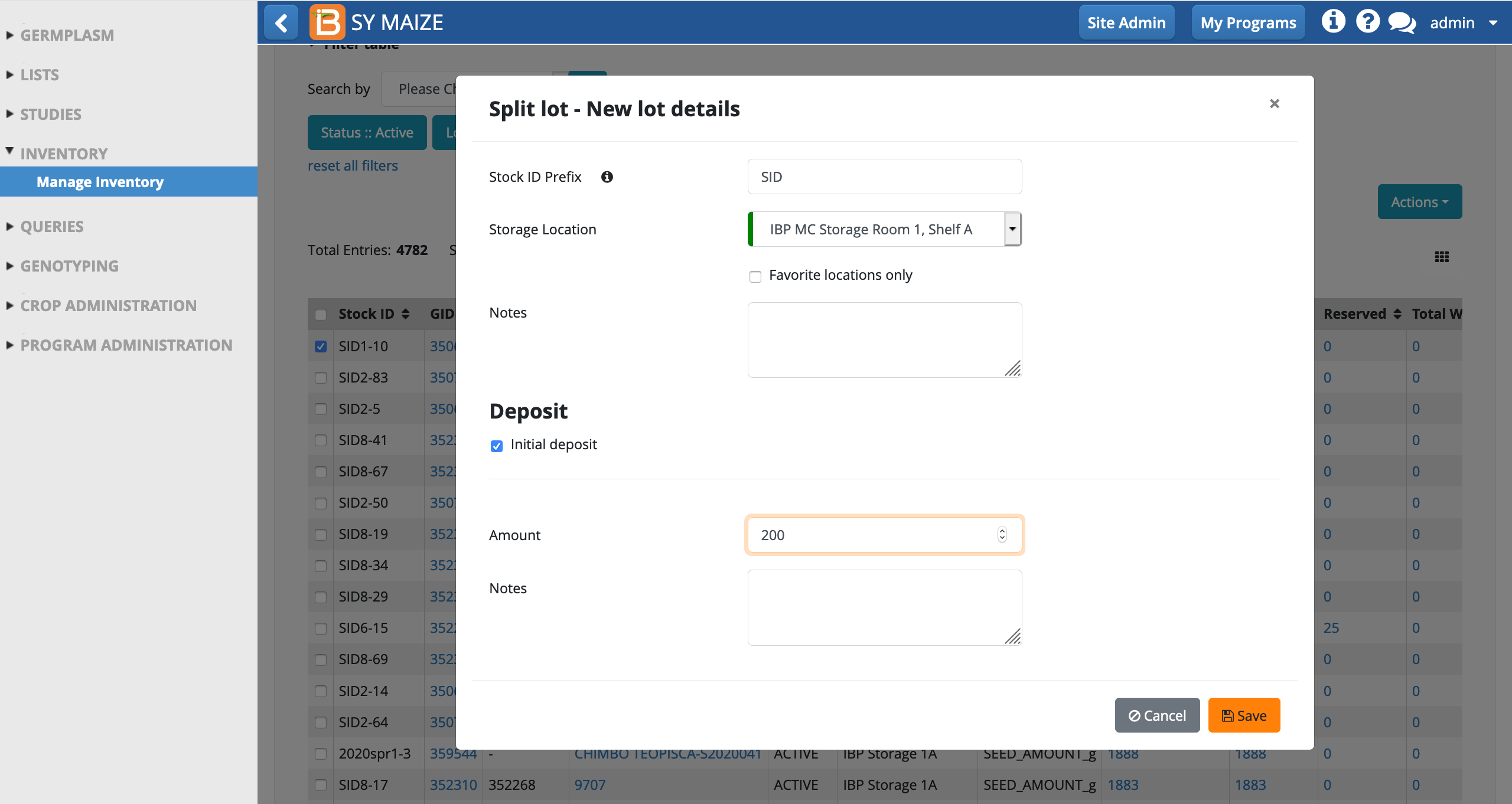
Notice the SID1-10 has been spit. 200g of its inventory have been added to a new lot, SID41-1.
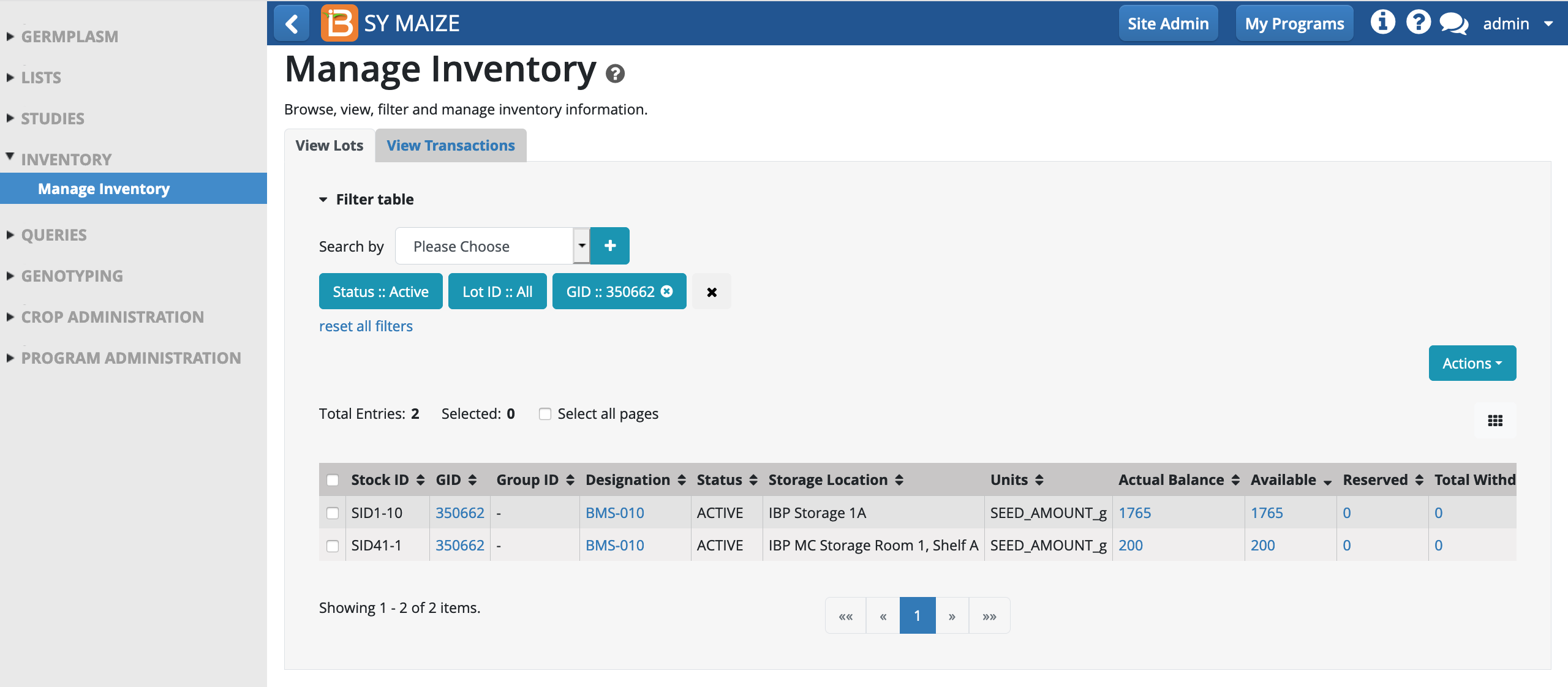
Close Lots
- When lots are discarded or no longer being filled, they can be converted from active to closed. Select lots of interest. Select Close lots from Actions menu.

- Closing lots will discard remaining inventory. Confirm that you would like to discard the remaining inventory.

Confirmation results in the creation of a confirmed discard transaction.

Export data and labels
- Select lot(s) of interest. Select Export data and labels from Action menu. Select the output format.

- Drag and drop the selected lot and germplasm data for export. Remember that Lot UID is appropriate for creating the bar code.

In this example all of the available fields have been selected for export to a .csv file.
- Optional Save Preset. The preset name will be available to automatically format will be available for export options in future.

The export file (.csv or .xls) contains all of the selected fields, including Lot UID, which can be used for barcodes in label-making software.

The export file (.csv or .xls) is suitable as a harvest list for recording deposits transactions in existing lots. LOT UID and Amount are mandatory. The import processes will not tolerate missing data in the worksheet file.

Mandatory LOT UID and Deposit Amount Columns. Optional Units Column - units are defined by the lot. Deposit amounts must be recorded in the appropriate lot unit, in this case kg.
Withdraw inventory
Withdraw inventory allows you to make a Withdrawal transaction. If "confirm transaction on saving" is selected the transaction status will be Confirmed. If "confirm transaction on saving" is selected the transaction status will be Pending.
- Select lot(s) of interest. Select Withdraw inventory from Action menu. Specify the amount to withdraw. Save. If the selected lots have more than one unit type, you will be asked the withdrawal amounts for each unit type. If "confirm transaction on saving" is selected, the subtraction from inventory will be immediate. If not selected, a reservation transaction will be created. Successful save of the transaction(s) will trigger a confirmation message.

Deposit inventory
Deposit inventory allows you add a single deposit transaction to existing lots through the user interface. If "confirm transaction on saving" is selected the transaction status will be Confirmed. If "confirm transaction on saving" is selected the transaction status will be Pending.
- Select lot(s) of interest. Select Deposit inventory from Action menu. Specify the amount to deposit. If "confirm transaction on saving" is selected, the addition to the lot will be immediate. If not selected, a pending deposit transaction will be created. Save. Successful save of the transaction(s) will trigger a confirmation message.

Import Deposits
Import a batch file (.csv or .xls) of transactions into existing lots. See more above, Export Data and Labels.
- Select import deposits.

- Select the file (.csv or .xls) containing the mandatory Lot UIDs and Deposit Amounts. Import.

- Map the column headings. Proceed. A success message indicates the creation of a confirmed deposit transaction.

Update balance
- Edit lot balance via UI. Select lot(s) and Update Balance.

- Record new balance with optional note. Save.

A confirmed adjustment transaction has been made.

Transactions
Transaction Filters
From View Transactions you have the ability to filter transactions by any detail or combination of details.
- Filter lots by any detail or combination of details. Select the detail from the "Search by" drop down and add to filter by selecting the + button.
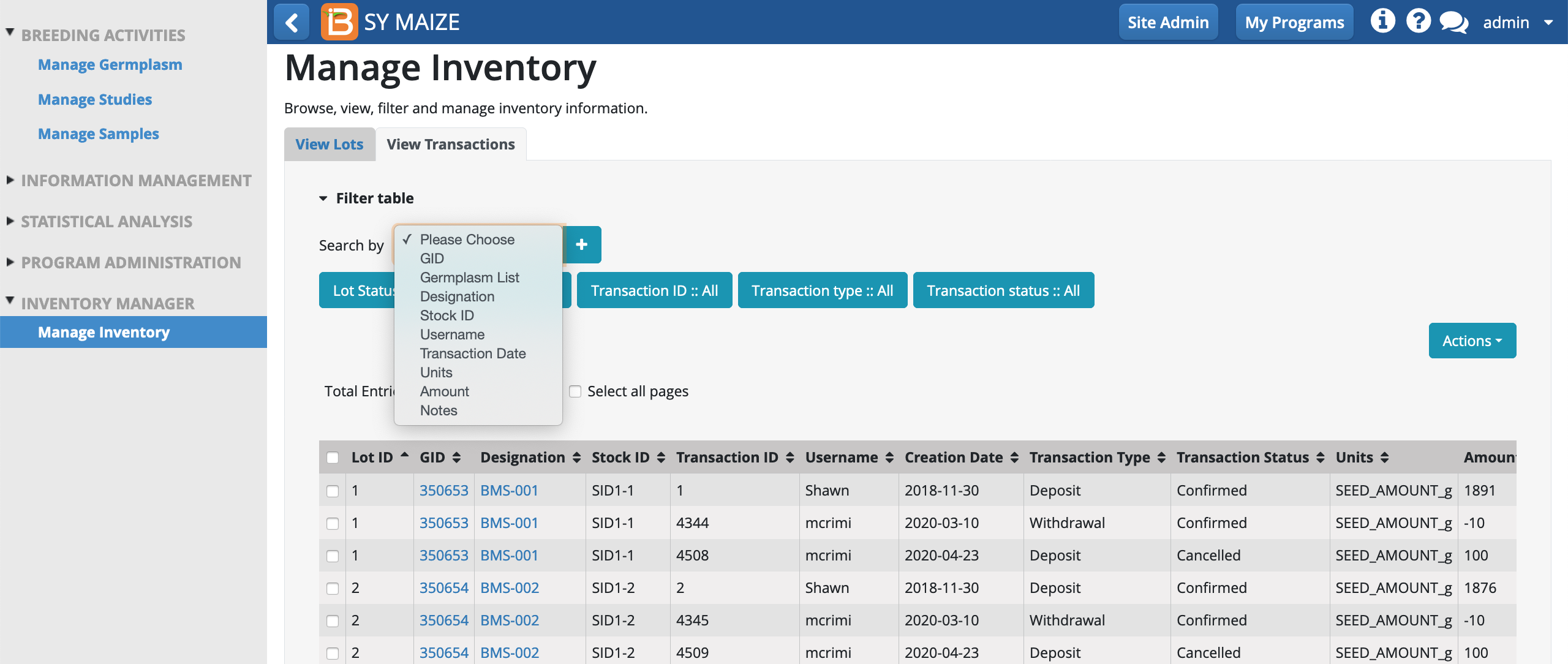
Filter Example: GID
- Select GID to filter by GID. Paste in GID(s) of interest. If searching for multiple GIDs enter comma separated values. Apply

GID 359635 has one lot, Lot ID 4008, and four transactions: 2 confirmed deposit, 1 pending withdrawal, and 1 pending deposit.
Filter Example: Transaction Status
- Choose transaction status options to filter by pending, confirmed, and/or canceled transactions. Apply filter.

The choosen filter presents only pending transactions.
Transaction Actions

Confirm Transactions
- Select a pending transaction. Select Confirm transactions from the Actions menu. Confirm.

Successful confirmation will be reported with a success message and the transaction status will be updated to Confirmed in the table.

The previously pending withdrawal transaction #4580 is now confirmed.
Export transactions
- Select transactions to export (.xls). Select Export transactions from the Actions menu.

An .xls file containing the selected transactions will be downloaded to a file on your computer specified by your browser settings, for example your Downloads folder.

Pending transaction update
When/if the amount of inventory withdrawn differs from pending withdrawal amount, the transaction file can be edited to reflect the true withdrawal amount.
* Import will fail unless every transaction in the .xls file has an updated amount, balance, or note. Delete all transaction without updates from the file for successful import.
- Export transactions (.xls) file containing only pending transactions (filtering and export instructions above). Edit the "New Amount" or "New Balance" columns with values greater than zero. "New Notes" are optional. Save.

- Select Pending transactions update from the Actions menu.

- Browse to the saved transaction file (.xls) and Import.

- Confirm recently updated transactions.

The withdrawals now reflect the amounts edited in the transactions file.
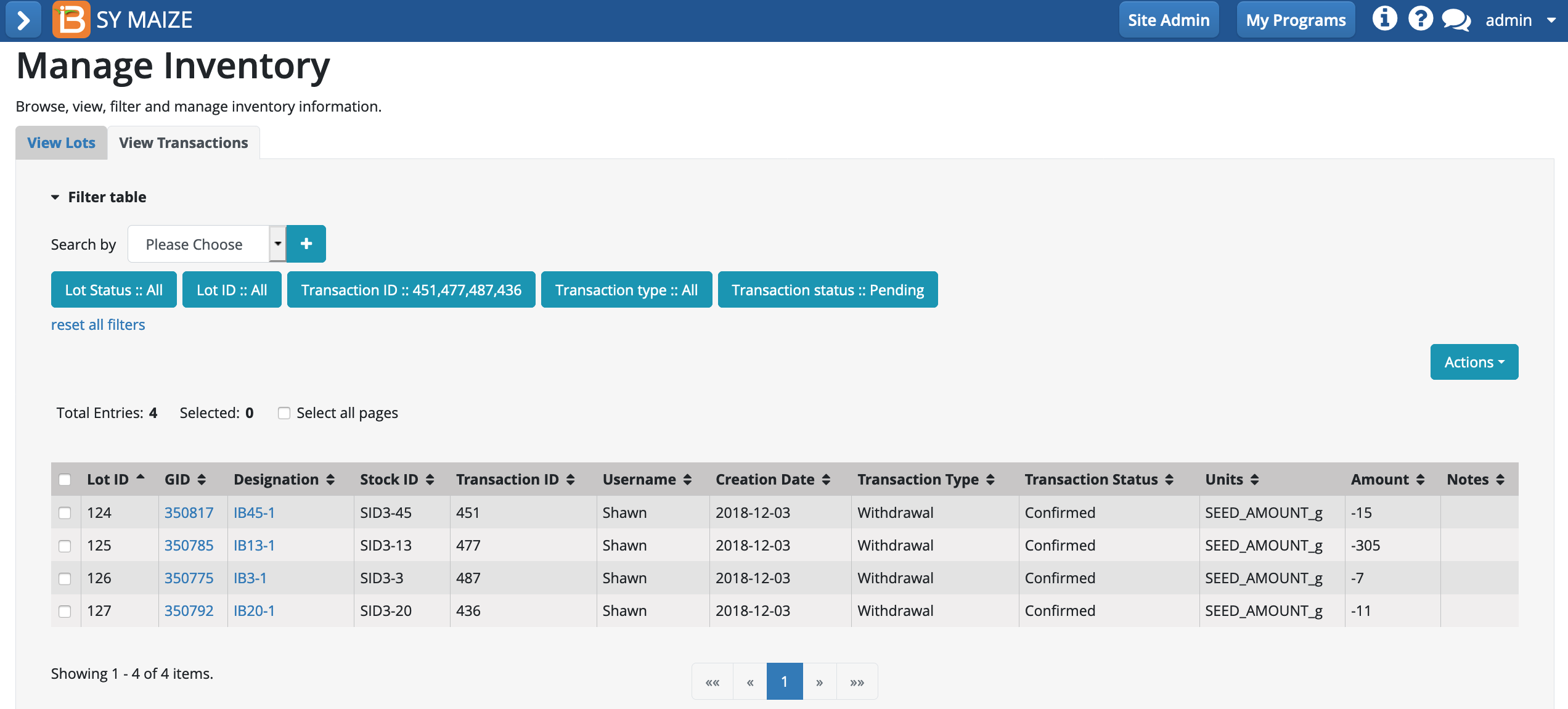
Cancel pending transactions
- Select pending transaction(s) to cancel. Choose "Cancel pending transactions" from the actions menu.
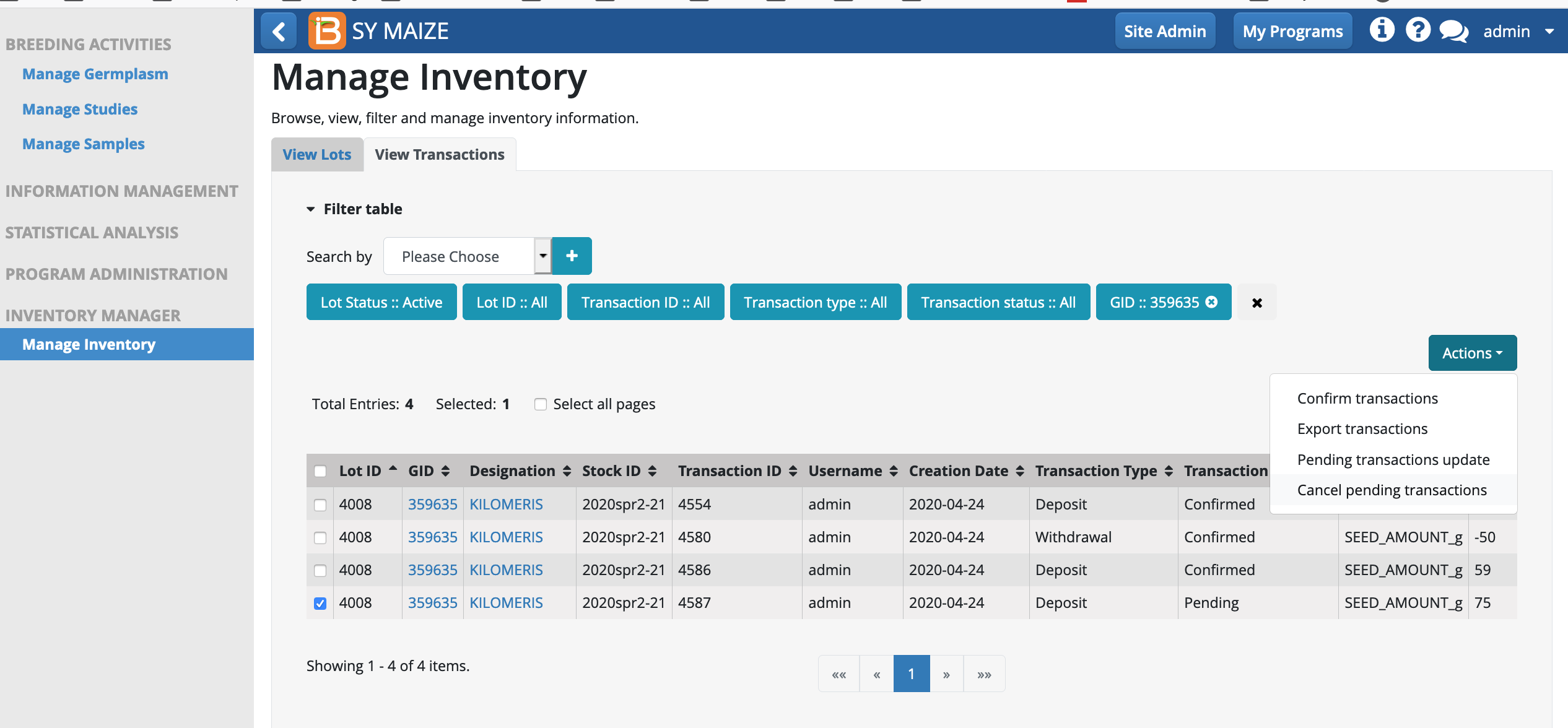
- Confirm.

The transaction(s) status is now "Canceled".
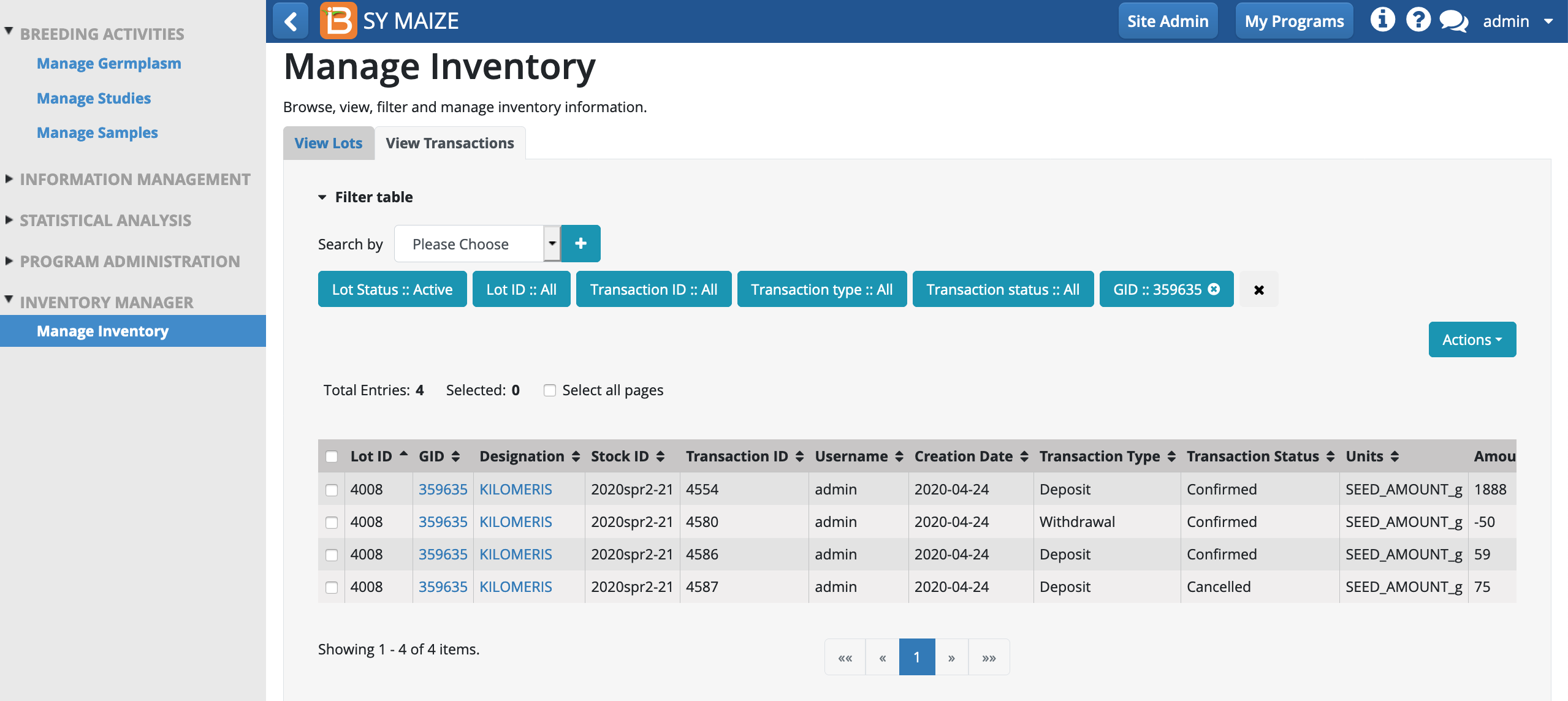
Manage Germplasm Inventory Functions
Create Lots
Creation of inventory lots from Mangage Germplasm is suitable for seed tracking independent of study, plot location, and harvest details; for example, adding seed to the BMS that has been gifted or purchased from outside the breeding program.
- Select the germplasm that need new lots. Select Create Inventory Lots from the Actions menu.

- Select Create lots from Action menu. Fill the details*. Save.
*Stock ID prefix cannot end in a number.
*If "confirm transaction on saving" is selected the transaction status will be Confirmed. If "confirm transaction on saving" is selected the transaction status will be Pending.
*Option to enter a single deposit amount. Multiple deposit amounts can be entered in a batch from the Manage Inventory> Import Deposits feature.
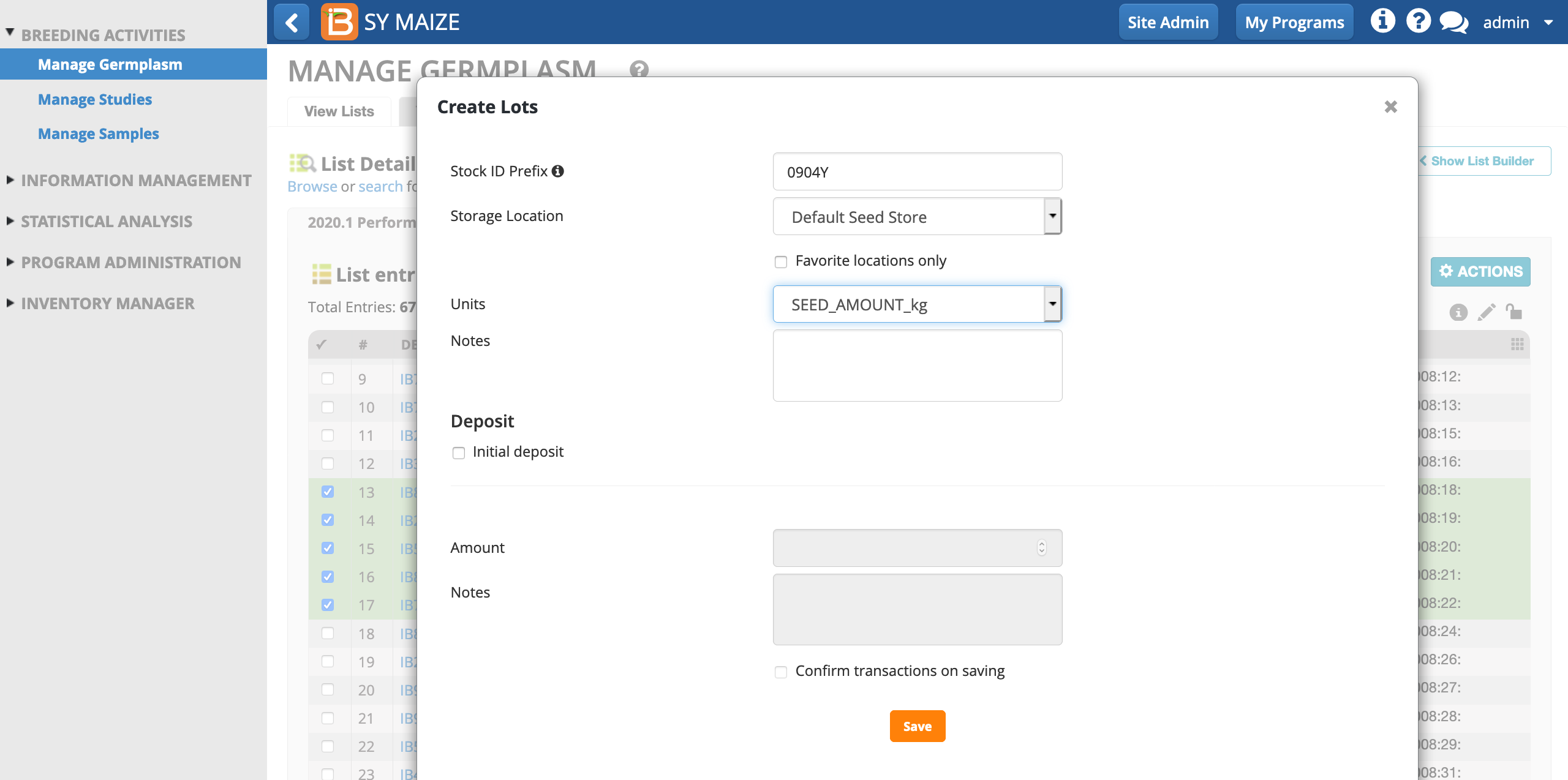
Now that lots are created, the LOT UIDs can be exported from Manage Inventory > Export Data and Labels, for batch collection of harvest amounts.

Manage Studies Inventory Functions
Prepare Planting Inventory
- Select plots to reserve inventory for planting.

- Specify the amount of seed to plant and review the transaction status. Confirm. If "confirm transaction on saving" is selected the transaction status will be Confirmed. If "confirm transaction on saving" is selected the transaction status will be Pending.

In this scenario, 100g of seed is reserved for each plot. The green checks indicate that the reserved amount is less than the available amount. Notice that entry one is associated with multiple stock ids; the other lots are available for selection via the drop down menu.
Conformation of planting inventory creates: (1) a reservation in Manage Inventory for each of the selected lots, and (2) populates the observations table with the Stock IDs corresponding to plot in which they will be planted.

Manage Inventory: Sorted by study of use, 4.5Kg of seed is reserved for planting in Trial 2020.3

Manage Studies Observation Table: Plots matched with corresponding Stock IDs for planting
Create Lots for Harvest (Beta)
Creating lots from the Crosses and Selections Action menu creates new lots with an initial deposit transaction that is linked to the plot of origin.
Beta Warning: Improvements to this workflow for batch actions are expected in upcoming versions. If you have concerns about this functionality, we recommend that you Create Lots via Manage Germplasm and Import Deposit amounts via Manage Inventory.
- From the Crosses and Selections tab, check the germplasm for which inventory lots are needed. Select Create lots from the Crosses and Selections Action menu.

Five selections are batch selected for lot and initial transaction creation.








- Select Create lots from Action menu. Fill the details. Stock ID prefix cannot end in a number. Save. If "confirm transaction on saving" is selected the transaction status will be Confirmed. If "confirm transaction on saving" is selected the transaction status will be Pending. (See figure legend below for important details on batch creation of lots and deposits.)
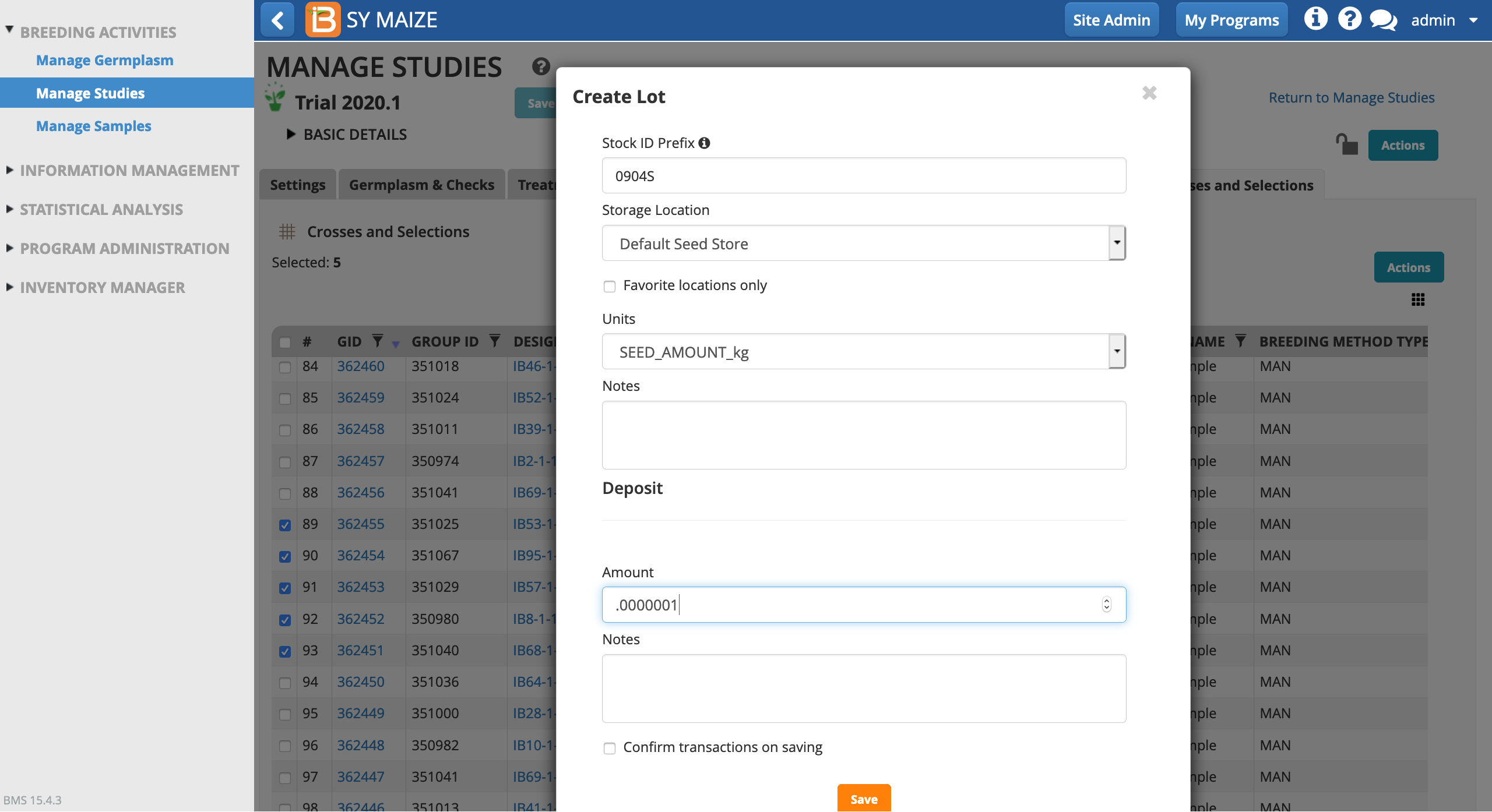
Notice that deposit amount is mandatory for this function. However a batch selection of 5 would not generally be expected to have a single amount. In order to proceed, a placeholder value must be entered and "Confirm transaction on saving" left unselected. Upon saving, the transactions will have pending status and the .csv file created via Manage Inventory>Transactions>Export Transactions can be edited to contain the true measured amounts (See above, Pending Transaction Updates). The impact of accidental confirmation of "placeholder" values can be minimized by making the placeholder value very small.


